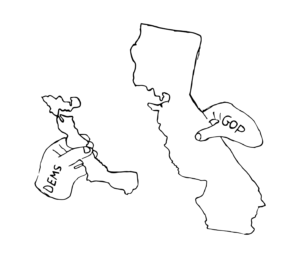On Jan. 15, a group of political activists gathered in a small conference room in Marysville, California with a single goal in mind: to divide California in two. Vice chairman Robert Paul Preston of the aptly titled “New California” movement took the stage at 11 a.m. to read out their own independence doctrine, declaring the creation of the 51st state: New California.
The doctrine, later released online, read, “The history of the present Governor and Government of California is a history of repeated injuries and usurpations, all having in direct object the establishment of a tyranny over the counties of New California and the State of California.”
While the current proposal isn’t very widespread, the potential drawbacks for California if such a proposal were ever passed could be disastrous, both economically and socially. And despite how crazy it might sound, many of these proposals are probably closer to becoming reality then you think. Over the course of its history, there have been over 220 proposals to divide California into two or more states, according to the Los Angeles Times. Just last year, billionaire Timothy Draper proposed dividing California into three separate states: Northern California, Southern California and California. The proposal is dangerously close to being added to the ballot, requiring only 365,880 signatures from registered voters.
To understand the economic catastrophe that would follow a California split, let’s first take a closer look at the proposal. The recently proposed “New California” would consume the vast majority of inland California, including Orange County, San Diego and Tahoe. The Bay Area, Los Angeles and all the coastal counties in between would be all that’s left of California. Los Angeles has a total GDP of $930 billion annually as of 2017, according to the US Bureau of Economic Analysis. Farther behind is the SF-Oakland area with a total of $431.7 billion annual GDP. If California were to be divided, the government of New California would be losing almost $1.4 trillion in GDP immediately.

What’s important to understand is that the greater an area’s GDP, the more wealth exists in that area. If more money is being spent on services and goods, that means more money is also being spent on taxes to fund state programs and projects. Without the strong economic foundations of the San Francisco and Los Angeles areas, New California would be stuck with a massive hole in its state budget.
Speaking of budget, there’s one other aspect of the state government’s money that would be incredibly difficult to manage if the state were to divide: debt. The state of California owes a total of over $255 billion in state and local debt, according to the nonprofit Truth in Accounting. If California were split, how would that debt be divided? Sure, local debts could be easily split, but what about statewide debt? How could you calculate how much each state owes? Could New California legally forfeit all debt due to its new statehood? The questions keep piling on, and the answers become obvious.
For evidence of this we can look to the secession of West Virginia from Virginia. The states seperated during the Civil War and spent much of the time afterwards arguing about how to split their debt. The dispute was left unresolved for 45 years, culminating in Virginia suing West Virginia. The case made it all the way to the Supreme Court before it was finally resolved. If the issue of debt could overwhelm a state like Virginia for almost half a century, imagine what sort of impact it would have on a state like California.
But even if you ignore the potential economic impact of such a split, the impact on the citizens of both states could be just as bad. A simple example would be Tahoe. I personally know lots of people whose families own homes in Tahoe. I have one friend who goes up to his Tahoe home every weekend during the winter to ski. But if California were divided the way that was most recently proposed, Tahoe and Marin would be in two separate states. And sure, traveling between states isn’t particularly difficult, but owning property in two is a completely different story. Homeowners of Tahoe and Marin would have to worry about different tax rates and property laws between the two states. House prices could also become wildly unstable due to the change in the economy. These additional struggles would make Tahoe property owners’ lives much more difficult, and might even force them to sell their homes.
The main point that the advocates for New California consistently bring up is the issue of representation. They claim that the current state of California is ruled by liberal leaning coastal cities like Los Angeles and San Francisco, while the more conservative central California is left completely unrepresented. By declaring independence, they hope to divide the electoral votes of the state, effectively creating a liberal California and a conservative California. But experts all agree that the numerous negative consequences that a division would cause far outweigh any possible benefits of representation. As political analyst Steve Maviglio said about one such proposal, “Creating three new governments, three new legislatures, three new governors [would] disrupt what we have as a state; all our prison systems, [and] our higher education systems.”
If you care at all about the future of the Golden State, then watch the ballot closely during midterm elections this year because the future of the state really does depend on it.







